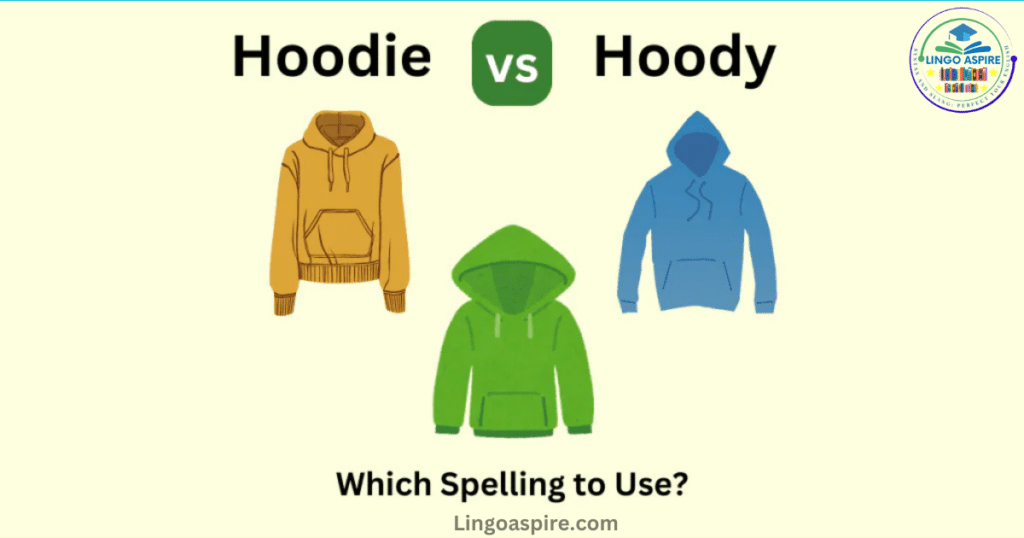When it comes to casual clothing, few pieces are as universally recognized and beloved as the hoodie. This simple yet versatile garment also referred to as a hooded sweatshirt, has become a staple in wardrobes around the world. But an interesting question often arises: should it be spelled as “hoodie” or “hoody”? This article dives deep into the origins, cultural significance, and linguistic nuances of this popular item of clothing, ensuring you’ll leave not only informed about its spelling but also enlightened about its rich history and role in global fashion.
Exploring the Terms: Hoodie or Hoody

The term hoodie refers to a type of sweatshirt with a hood, which can include features such as kangaroo pockets and drawstrings. Its alternative spelling, “hoody,” is less common but still used within certain circles and regions. Understanding which spelling to use can depend on several factors including regional preferences and the context in which you’re writing.
In formal writing, “hoodie” is predominantly used, especially in American English, whereas “hoody” appears more frequently in British English texts. This divergence highlights the spelling debate that often surrounds this garment, reflecting deeper cultural and linguistic trends.
Historical Context and Evolution
The hoodie’s journey from a practical garment to a symbol of street fashion is as rich as it is fascinating. Originally designed in the 1930s for laborers in cold New York warehouses, the hoodie was meant to provide warmth and comfort. However, by the 1970s, it had been adopted by various subcultures, including hip-hop and skateboarding, which propelled it into the fashion mainstream.
The transformation continued as the hoodie became associated with youth culture and rebellion, partly driven by its portrayal in popular media and its adoption by high-profile figures in the music industry. This backdrop not only solidified its status in streetwear but also in high-end fashion, where designers began to reinterpret it with luxurious materials and bold branding.
Geographical Variations in Spelling
The spelling variations between “hoodie” and “hoody” are not just a matter of orthography but also highlight differences in regional language use. For instance, in the United States, “hoodie” is the preferred term, aligning with other American English spellings that often simplify the language. Conversely, in the UK, both “hoodie” and “hoody” are used, though “hoodie” remains dominant in commercial and popular usage.
This variation can be seen in how the garment is marketed and discussed in different countries, reflecting broader linguistic and cultural trends that influence everyday language.
The Hoodie in Modern Fashion
Today, the hoodie is more than just a comfortable garment; it’s a fashion statement that speaks to versatility and style. Major fashion brands have embraced the hoodie, integrating it into collections that blur the lines between high fashion and casual wear. The hoodie’s ability to transition from gym wear to runway attire showcases its unique position within the fashion industry.
Fashion shows and celebrity endorsements have helped elevate the hoodie, transforming it from its humble beginnings to a symbol of contemporary style. These moments are pivotal in understanding the hoodie’s role in fashion branding and its impact on digital culture and SEO, as brands leverage its popularity to boost online visibility.
“Hoodie” vs. “Hoody”

Here’s a table comparing the key differences between the terms “hoodie” and “hoody,” focusing on aspects like regional preferences, usage in popular culture, and spelling conventions:
| Aspect | Hoodie | Hoody |
|---|---|---|
| Preferred Spelling | Commonly used worldwide, especially in American English. | Less common; occasionally used in British English. |
| Regional Usage | Dominant in the US, Canada, and Australia. | Found more in the UK and parts of Europe. |
| Popularity in Media | Frequently appears in American media and popular culture. | Less visible; occasionally appears in British media. |
| Fashion Industry | Widely accepted and used in global fashion branding. | Occasionally used by specific brands for stylistic choices. |
| Cultural Significance | Seen as a symbol of casual, street, and youth culture. | Similar cultural significance, but less prevalent. |
| Linguistic Consistency | Consistently spelled in most formal and informal writing. | Variable spelling, depending on the writer’s preference. |
| Search Engine Optimization (SEO) | Highly searchable and used keyword in digital marketing. | Less used, which may affect search visibility slightly. |
This table illustrates how “hoodie” is more universally recognized and preferred, particularly in American English and global fashion contexts, whereas “hoody” remains a valid but less common alternative, with regional variations influencing its use.
Linguistic Insights: Pluralization and Usage
The pluralization of “hoodie” and “hoody” follows standard English rules, turning into “hoodies” and “hoody” respectively. In writing, the usage of these terms can vary, with “hoodies” being the more common form. The linguistic choice here can subtly influence reader perception and text readability, demonstrating the importance of spelling in effective communication.
The Influence of Media and Pop Culture
Pop culture has played a crucial role in popularizing the hoodie, with its appearances in films, music videos, and television shows contributing to its iconic status. The garment has often been linked to key cultural movements, serving as a symbol of identity and belonging for many groups.
Moreover, the rise of digital media has facilitated the spread of various hoodie styles, influenced by celebrities and online retailers. As influencers continue to shape trends, the hoodie remains at the forefront of casual fashion, constantly evolving yet always retaining its core appeal.
Usage Examples of “Hoodie,” “Hoody,”
Casual Wear
A hoodie is often seen as the epitome of comfort in casual wear. It’s a go-to piece for those looking for a simple yet functional garment to keep warm or just to relax in. Thanks to its soft material and loose fit, a hoodie can be found in nearly everyone’s wardrobe, worn at home, for running errands, or as a cozy option for casual outings.
Athletic and Outdoor Activities
Hoodies are also popular in athletic settings, where they are used for warm-ups or cool-downs due to their easy-to-wear design and the comfort they provide. Outdoor enthusiasts wear hoodies while hiking, camping, or engaging in outdoor sports because they offer warmth without being too heavy.
Work Environments
In more relaxed work environments, particularly in creative and tech industries, hoodies are a common sight. They represent a shift from traditional business attire to a more modern, laid-back dress code that supports comfort and personal expression.
School and College Fashion
For many students, the hoodie is part of the unofficial school or college uniform. It serves not only as a practical piece for the varying climates on campus but also as a canvas for personal expression, often adorned with school colors, logos, or custom designs that flaunt club affiliations or personal interests.
Street Fashion
In the realm of street fashion, the hoodie is indispensable. It’s often featured in the collections of streetwear designers, where it might be embellished with bold prints, statements, or unique design elements. The hoodie’s role in street fashion is tied to its roots in the hip-hop culture and its adoption by various subcultures over the decades.
High Fashion
The hoodie has transcended its casual roots to become a valued piece in high fashion. Designers have reimagined the hoodie in luxurious fabrics, unconventional cuts, and with avant-garde detailing, making it a fashionable choice that challenges traditional fashion norms.
Activism and Social Movements
The hoodie has also played a role in social movements and activism, symbolizing solidarity and conveying messages. Its association with youth and resistance has made it a powerful tool for expression in protests and awareness campaigns.
Merchandising
Hoodies are a popular choice for merchandising, used by bands, brands, and even events as a medium for fan merchandise. They are favored for their practicality and wide appeal, making them excellent souvenirs or promotional items.
The hoodie’s usage is as diverse as its designs, embodying a blend of functionality, fashion, and statement-making power. This versatility is what makes the hoodie a perennial favorite in various spheres of life, from everyday casual wear to high-stakes fashion runways.
Conclusion
Whether you spell it as “hoodie” or “hoody,” this garment continues to be a cornerstone of both comfort and style in the fashion world. Its journey from a practical piece to a cultural icon is a testament to its adaptability and enduring popularity. By understanding its history, linguistic nuances, and cultural impact, we gain not only clarity on its correct spelling but also a deeper appreciation for this ubiquitous piece of clothing.
As we’ve explored the many facets of the hoodie, we invite you to reflect on how this garment has influenced your style and cultural experiences. What are your thoughts on the “hoodie vs. hoody” debate, and how do you prefer to spell it? Share your stories and join the conversation about this versatile and timeless garment.
Sources
Fashion Industry Analysis
- Vogue: Their official website often features articles about fashion trends, designer interviews, and runway show reviews. You can use their search function to find articles related to the evolution of hoodies in high fashion.
- Business of Fashion (BoF): Known for its in-depth analysis of the fashion industry, BoF provides articles and reports on how casual garments like hoodies have transitioned into high fashion. A subscription might be required for some articles.
- Women’s Wear Daily (WWD): This is another excellent source for the latest news on fashion brands and trends. Their site covers a wide range of topics including how streetwear influences mainstream fashion brands.
Cultural Studies Journal
- JSTOR: An excellent resource for academic articles covering a wide range of topics including fashion’s cultural implications. You’ll find peer-reviewed articles here that delve into the cultural significance of clothing items like hoodies.
- Google Scholar: This is a freely accessible web search engine that indexes the full text or metadata of scholarly literature across an array of publishing formats and disciplines.
Consumer Behavior Research
- Statista: Offers statistics and studies from more than 22,500 sources. You can find information on consumer behavior regarding fashion items such as hoodies.
- Mintel: Provides market research reports covering the UK, Europe, USA, and International consumer markets for various products including clothing. Mintel’s reports might require a subscription or purchase.
- Euromonitor: This site offers comprehensive data and insights into consumer trends around the world, including fashion.







